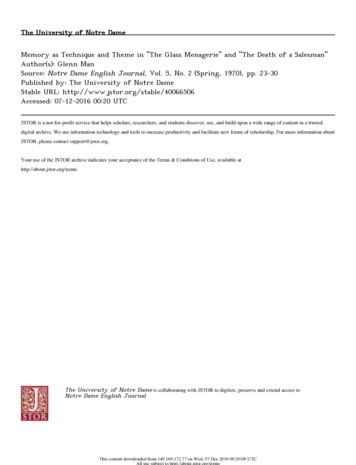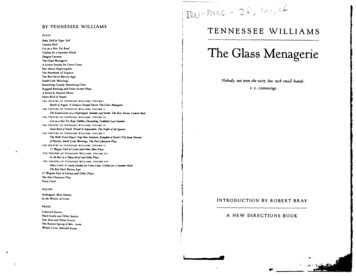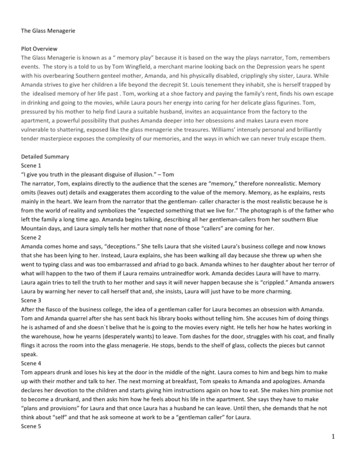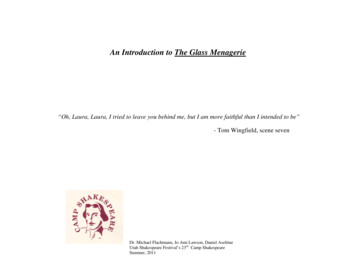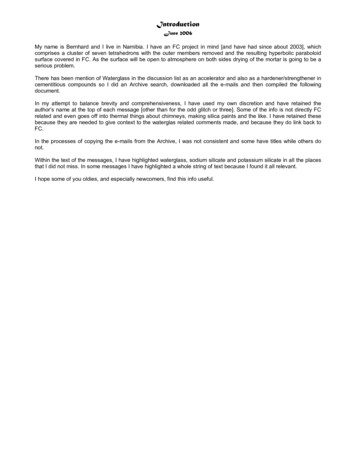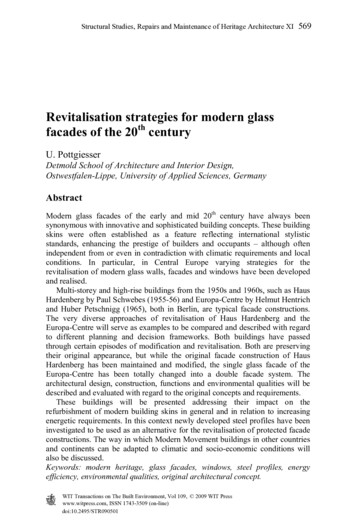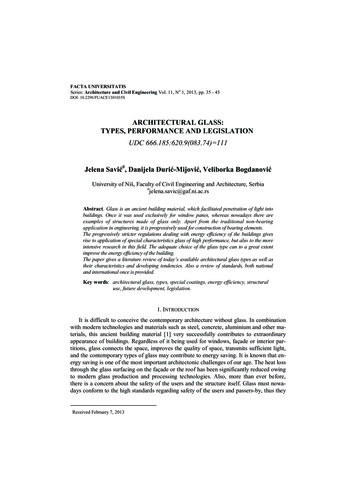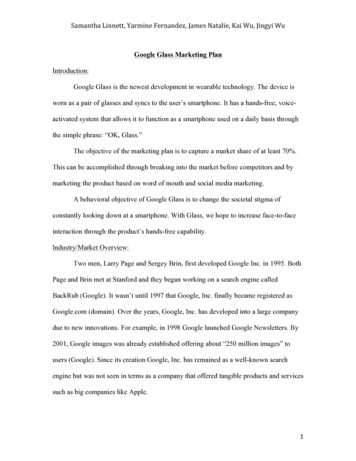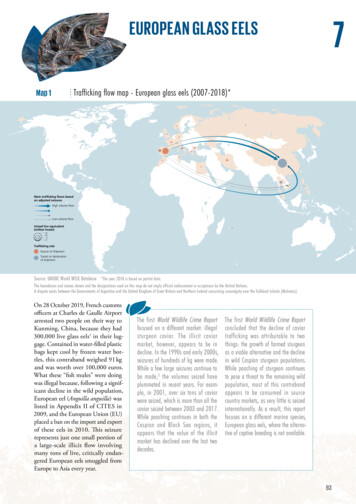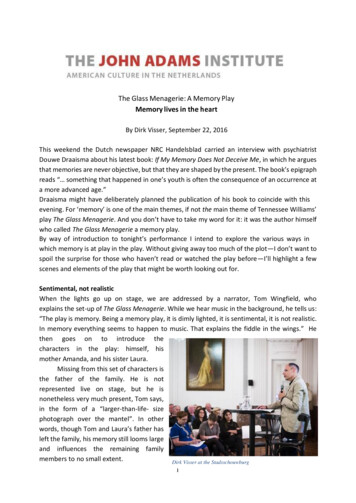
Transcription
The Glass Menagerie: A Memory PlayMemory lives in the heartBy Dirk Visser, September 22, 2016This weekend the Dutch newspaper NRC Handelsblad carried an interview with psychiatristDouwe Draaisma about his latest book: If My Memory Does Not Deceive Me, in which he arguesthat memories are never objective, but that they are shaped by the present. The book’s epigraphreads “ something that happened in one’s youth is often the consequence of an occurrence ata more advanced age.”Draaisma might have deliberately planned the publication of his book to coincide with thisevening. For ‘memory’ is one of the main themes, if not the main theme of Tennessee Williams’play The Glass Menagerie. And you don’t have to take my word for it: it was the author himselfwho called The Glass Menagerie a memory play.By way of introduction to tonight’s performance I intend to explore the various ways inwhich memory is at play in the play. Without giving away too much of the plot—I don’t want tospoil the surprise for those who haven’t read or watched the play before—I’ll highlight a fewscenes and elements of the play that might be worth looking out for.Sentimental, not realisticWhen the lights go up on stage, we are addressed by a narrator, Tom Wingfield, whoexplains the set-up of The Glass Menagerie. While we hear music in the background, he tells us:“The play is memory. Being a memory play, it is dimly lighted, it is sentimental, it is not realistic.In memory everything seems to happen to music. That explains the fiddle in the wings.” Hethen goes on to introduce thecharacters in the play: himself, hismother Amanda, and his sister Laura.Missing from this set of characters isthe father of the family. He is notrepresented live on stage, but he isnonetheless very much present, Tom says,in the form of a “larger-than-life- sizephotograph over the mantel”. In otherwords, though Tom and Laura’s father hasleft the family, his memory still looms largeand influences the remaining familymembers to no small extent.Dirk Visser at the Stadsschouwburg1
In this opening monologue, Tom gives an important hint to the audience. This is amemory play, it is sentimental, it is not realistic. In other words, far from conveying an objectivetruth, showing us what really happened, we witness a person’s colored memories. What we aregoing to see is what Tom remembers; it would probably not stand up in court.And not only areevents colored—they may not have happened exactly as Tom remembers them—but the othercharacters, Amanda, Laura, the absent father, and the gentleman caller, are not depictedobjectively either.Throughout the play, Williams uses subtle and creative means to remind us that whatwe are witnessing is indeed memory and not reality. A scene worth looking out for in thisrespect is the one where Tom arrives home at five in the morning. When the scene opens wehear “a church tolling the hour of five”. Tom arrives home, and has a brief discussion with hissister, who admonishes him about his coming home drunk. Then, suddenly, we hear theclock strike six, but we are not more than five minutes into the scene. Then Amanda’s voicecalls out, “Rise and shine,” Tom sits up in bed, and Laura says “Tom! It’s nearly seven.”Of course, we could read this as an indication that Laura cannot properly tell the time, orthat Tennessee Williams messed up his writing, but more likely we are seeing what Tom himselfcan remember, i.e. the moments when he is awake. Apparently, between the hours of six, whenhe should have gotten up, and seven, when Laura warns him about the time, Tom was asleep.Another way in which the script subtly makes clear that its representation of events isnot realistic, is the manner in which the play is structured. The Glass Menagerie does notcomply with the Aristotelian unities of time, place, and action, nor does it follow the rules ofthe 19th and early 20th century’s so-called well-made-play, which consists of three acts, inwhich the action is continuous, i.e. the events in Act Two immediately follow those of Act One.Instead, Tennessee Williams gave his play a structure of seven independent scenes ofincreasing length.The first scene is the shortest. The seventh, in which events come to a head, is aboutas long as the first five combined. Events depicted in these scenes do not follow each otherimmediately, but they may be days, weeks, or even months apart. Combined, they tell Tom’sstory of how he came to leave his family. Of course, the scenes show events as Tom remembersthem: they are not objective renditions of reality. In the longest scene, Tom is not evenpresent. It clearly depicts events as he imagines they might have occurred.Helene Davos in The Glass Menagerie2
Escape from a trapSo what story does The Glass Menagerie tell? I need to be careful here, of course, in ordernot to give too much away. The events that Tom unfolds for us concern his family, consistingof his mother Amanda, his sister Laura, and—not present in the flesh but, as he says in theopening monologue, hovering over them in the form of his portrait - father Wingfield, whofor some reason or other fled the family. From the scenes in which Tom acts as narrator, itbecomes clear that he, in his turn, has also run away. This is explained partly in the characterdescription on page one of the script. “His nature is not remorseless, but to escape from a traphe has to act without pity,” Williams writes.The trap he has to escape from is both his family and his house, a suffocatingapartment in St. Louis. Tom wants to be a writer, but instead, being the man in the house, hehas to earn a living working in a warehouse. His dominant mother does not even allow himto read—when she finds a copy of D.H. Lawrence’s Lady Chatterley’s Lover in the house, shereturns it to the library: such filth has no place in a decent family like hers. The only thingthat seems to keep Tom sane are his nightly exploits, to the local cinema, he says—but can wetake his word on trust? — where he can dwell in a world of make-believe.Throughout the play, Tom and his mother are constantly at loggerheads. One quarrelfollows another. But what unites them are the love for and worry about the daughter of thefamily, Laura. When in the end Tom leaves the family, he feels guilty not so much for havingdeserted his mother, but for having left Laura behind. The memories that haunt him—andwhich are enacted in the play—are unhappy ones: reliving them does not exorcise them. Onthe contrary, at every performance of The Glass Menagerie he has to go through them again.Tom may suffer from unhappy memories, but he is not the only character to do so.His mother, Amanda, is just as caught up in her memories. From the moment she appears onstage, she chatters incessantly about her—allegedly—happy past. She grew up in America’sDeep South, the land of the cotton plantations.For those who have seen Gone with the Wind, Amanda Wingfield is the ScarlettO’Hara of the early scenes of that movie, living the easy life of a so-called Southern Belle,whose only goal in life is to win the hand of an eligible young suitor, a Beau. If we are tobelieve Amanda, she used to be the center of attention. Crowds of young men would offerthemselves to her as potential marriage material. Her children, Laura and Tom, have heardAmanda’s recollections of her “gentleman callers” many times before, but they indulge her.There is something strange about Amanda’s memories, however. If she was so surroundedby fine young men, how come she ended up with a husband who first took her to a tinyapartment in a poor neighborhood of St. Louis, and then left her to fend for herself? Tomand Laura, and the audience as well, quickly sees Amanda’s long monologues aboutgentleman callers for the unreliable memories they are: probably Amanda was never thepopular Belle she claims to be, but in order to survive her current dire circumstances sheneeds to create this memory of a happy youth.Though she seems a very different character from her mother and brother, memoriesalso play an important role in Laura’s life. She may not speak half as much as the othercharacters in the play—she even has fewer lines than the gentleman caller who appears only3
in scenes six and seven—she is nevertheless the character who drives the action of the play.Completely the opposite of her chatterbox mother, Laura is extremely shy and seems happiestwhen she can withdraw into her world of music and her collection of glass animals, the “glassmenagerie” that gives the play its title. Laura is that kind of person who is unable to holdherself together in the outside world.During the opening scenes of the play, we learn that she attends a business college,where she takes typing lessons. However, it becomes clear very quickly that due to hervulnerable character she could not face her teachers and fellow-students, and was unable tostand the stress of work. Instead, she spent all her days walking in the park, not daring to gohome in fear of her mother. Of course, as these things go, she is found out. WhenAmandarealizes that Laura is unfit to make a living for herself, she decides that she and Tomshould find Laura a suitor, a “gentleman caller,” so that she may get married and be providedfor.Like Tom and Amanda, Laura also carries with her memories of a happy past. In oneof the few scenes where she and her mother are having a heart-to-heart conversation, sheconfesses that during high school she was in love with one of the most popular boys, JimO’Connor. He even had a pet name for her, ‘Blue Roses’, which suggests that he also feltaffection for her. However, their love came to nothing—how many high school loves do?—and Jim later got engaged to a girl called Emily Eisenbach. It appears that after having lostJim, Laura feels that she has missed her one and only chance to find a future husband. Allshe has left are her memories of Jim, memories which are much a fantasy world as her glassanimals.Even more than the absent father, Laura is at the center of the play. When Amandaand Tom hatch a plan to find Laura a gentleman caller, events are set in motion that willdrive the play to its disastrous conclusion, which will prompt Tom to leave the householdforever. Rest assured, I won’t say anything more—see for yourselves how things come to ahead when Tom announces that he has found a gentleman caller.Tom and TennesseeClearly, memory, however unreliable, plays an important rolein the lives of the characters of the play. But it is also in anothersense that The Glass Menagerie is a memory play. Many criticshave pointed out that this is Tennessee Williams’ mostautobiographical play, with characters and events resemblingpersons and occurrences in William’s own life. In theirenthusiasm, they have compiled long lists of similaritiesbetween the play and Williams’ life, suggesting that what we areseeing is not so much the fate of a fictional family, but theauthor’s life story instead.Of course, these lists of parallels make for interestingreading. However, we need tobe careful not to read The GlassMenagerie as a reliable autobiography. Though the play4Tennessee Williams in 1965
obviously relies on Williams’ own memories, it is, as Tom warns us in the openingmonologue “sentimental, not realistic”. But bearing this in mind, let’s explore a few of theseparallels between fiction and real life.Most obviously, the play’s narrator, Tom Wingfield, shares his initials and his first namewith the author. Williams’ official name at birth was Thomas Lanier Williams; he adopted thename “Tennessee” later in life.Like the Wingfields, the Williams family originated from the Deep South. And likeAmanda, Williams’ mother, Edwina, feeling very much out of place in St. Louis, never tired ofrecounting to her children how in the pre-Civil War days she was very much a SouthernBelle. And a successful one at that, receiving on one single day no fewer than thirty gentlemancallers. Like Amanda, however, she made the mistake of marrying the wrong man. InEdwina’s case this was a man called, believe it or not, Cornelius Coffin Williams. His secondname should have given her cause to think again. But marry him she did, and like the Wingfieldfamily the Williamses ended up in a coffin-like apartment in St. Louis, Missouri. For those whowant to visit it, the exact address is 6544 Enright Avenue. It is this apartment where youngTennessee Williams spent his early adulthood, like Tom dreaming away by the sound of themusic from the dance hall next door.Also like Tom, Tennessee Williams fled the St. Louis home, leaving his family behind. Hewas subsequently filled with remorse for deserting his frail sister, Rose, who resembles thecharacter of Laura to a large extent. She also could not handle the pressure of life at a businesscollege. Like Laura, she would wander around in the park, afraid to tell her mother that she haddropped out. At home, she would withdraw into her world of music records and her collectionof glass animals.However, though most critics, and Tennessee Williams himself, were eager to point outRose’s own glass menagerie, in 1995 the critic Lyle Leverich discovered that the collectionof glass animals that really was the model for Laura’s collection belonged not to Rose but to aMrs Maggie Wingfield, who lived in the same town during Williams’ childhood years. Yes, sheis the person from whom the Wingfield family derive their name.And that is not the only difference between fictional Laura and real-life Rose. Rose, whosuffered from schizophrenia—a fact which Williams did not include in the play, supposedlybecause he wanted to spare his sister—was not as silent and withdrawn as Laura. In fact, sheseems to have been as talkative as her mother, and Amanda Wingfield.Eelco Smits in The Glass Menagerie5
The greatest parallel between Tennessee Williams and Tom Wingfield is the fact thatthey feel guilty for abandoning their sister. During Williams’ absence from home, Rose hadto be admitted to ment
The Glass Menagerie: A Memory Play Memory lives in the heart By Dirk Visser, September 22, 2016 This weekend the Dutch newspaper NRC Handelsblad carried an interview with psychiatrist Douwe Draaisma about his latest book: If My Memory Does Not Deceive Me, in which he argues that memories are never objective, but that they are shaped by the present. The books epigraph reads
